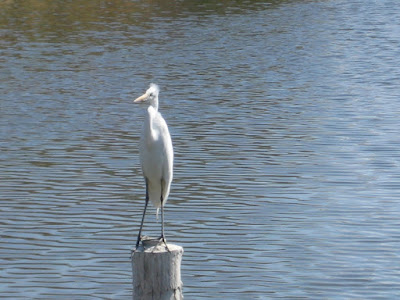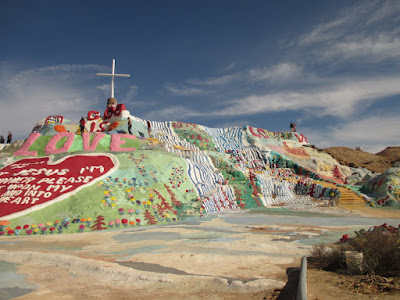Draw a circle around Palm Springs and the greater Coachella Valley and you’ll find some interesting destinations. The high desert and Joshua Tree Natural Park are just an hour away. Swing around the other way and you can be in the mountaintop artist community of Idyllwild in the same amount of time. Two hours will get you to Los Angeles, Laguna Beach or San Diego.
But head east and another world opens up. Skirting the Salton Sea, you could end up in East Jesus and West Satan. It’s a ‘lost world’ replete with fascinating characters, RV slummers and a few stragglers who look more like human residue scrapped up from the bottom of civilized society. It’s a step back in time and void of any semblance of the world up north of it. East Jesus is next to West Satan in an enclave known simply as ‘the slabs.’ To get there, you have to pass the Fountain of Youth trailer park on the way into town. I think you get the picture.
But
before you get to this enclave of ‘Mad Max’ look-a-likes, you must pass by
America’s own Dead Sea. While that moniker might be a little premature, the
lake bed has been dying for years and little has been done, thus far, to
reverse that trend.
The Salton Sea is California’s largest lake measuring more than 35 miles long and 15 miles wide in spots. It has a surface area of over 380 square miles and sits at 332 feet below sea level. The sea was created back in 1905 as the result of an accidental break in a canal cut into the Colorado River. For 16 months, the river ran unchecked into the lowest area around; the salt basin which became the Salton Sea.
But
it wasn’t the first time that the area had seen a large body of water.
Thousands of years earlier, Cahuilla and other California Indians occupied
those lands. When they first arrived, the Salton Sink held a much larger body
of water – ancient Lake Cahuilla. Geologists estimate the sea has appeared and
then disappeared about every 400-500 years.
After the Indians, came the first settlers and railroad men who built a line of the Southern Pacific Railroad through a part of the sea. Nearby agriculture began to grow in what are now the communities of Coachella, Thermal and Mecca.
But two hurricanes; Kathleen in 1976 and Doreen in 1977, caused such wide-spread damage to neighboring farm lands that the runoff caused a major increase in the salinity of the sea. That, in turn, caused major fish-kills and bird-kills and created such a major issue with noxious odors that residential development came to a stop. Today the salinity level of the sea stands at 45 ppt. Only the tilapia fish is able to survive in such waters. While fishing is still good for the tilapia, fish kills continue to plague the area with their harsh smells.
Along the northeastern edge of the Salton Sea lies one of the world’s most important winter stops for migrating birds traveling the Pacific Flyway. The migration begins in October and by January more than 400 species of migrating birds fill the skies above the sea. By the end of May, the birds have moved on. Over the centuries the fragile ecosystem of the area has provided sanctuary to an extremely diverse collection of wildlife and the critical habitats that support and nurture them.
For
example, the sea holds millions of fish that feed the masses of wintering
birds, including herons, egrets, brown and white pelicans and kingfishers. In
the fall, birds of prey arrive. Among them are peregrine falcons, osprey and
ferruginous hawks. The fields and wetlands adjacent to the sea support huge
flocks of snow geese, ducks, sandhill cranes and California’s largest
population of burrowing owls.
It will take years, perhaps decades before the sea might possibly return to its past glory. More feasibility studies will be made, more funding sought and grand schemes hatched. The possibilities for commerce, recreation and development are enormous. Until then the Salton Sea is a magical place for walk the shoreline, observe the birds and time your visit to avoid the smell. A small price for a wonderful watery treasure in the middle of the desert.
Living below the ‘Line of Living’ might be a good description for our next destination. It resembles a ‘Mad Max’ holiday replete with a shoe tree, mummies at East Jesus, flying dune buggies, a conflagration in Slab City and a death stare at Bombay Beach. All of this and more for a quiet outing to the back side of civilization.
Salvation Mountain is one of the premiere examples of folk art in the middle of nowhere America. The site has become a mecca for those intrigued with this kaleidoscope of painted hills, crude cave dwellings and religious scripture. The cave’s paint can and hay bale construction would challenge even the most daring of spelunkers.
The artwork is made from adobe, straw and thousands of gallons of lead-free paint. It was created by the late Leonard Knight (1931-2014). A deeply religious man, Knight created an art piece that encompasses numerous murals and areas painted with Christian sayings and Bible verses. Knight’s philosophy was built around the ‘Sinners Prayer.’
The old mountain carver is gone now and replaced by Jesus People and their small hugging kids. Many visitors bring paint to donate to the project and a group of volunteers have been working to protect and maintain the site.
Maybe it was the line of dune buggies flying over the hilltop and descending on Salvation Mountain that signaled our next decent into hell’s crude cousin. Slab City otherwise known as ‘The Slabs’ is a snowbird campsite used by recreational vehicle owners alongside squatters from across North America. It takes its name from the concrete slabs that remain from an abandoned World War II Marine barracks of Camp Dunlap.
It’s estimated that there are about one and fifty permanent residents (squatters) who live in the slabs year around. Some live on government checks, others just want to live ‘off the grid’ and a few come to stretch out their retirement income. The camp has no electricity, no running water, no sewers or toilets and no trash pickup service. Sounds like a dry run for the apocalypse.
Despite the free shoe tree on the way into town and the free library, most of the residents have sectioned off their trailers, tents and sleeping bags with tires, pallets or barbwire. Free is free unless it comes to their piece of the desert then even squatters want their personal space recognized.
No trip to Slab City would be complete with a swing by East Jesus. This outdoor gallery has been described as an experimental, sustainable art installation. Made from discarded material that has been reused, recycled or repurposed, East Jesus encourages visitors to imagine a world without waste in which every action is an opportunity for self-expression.
I think West Satan is a simply a suburb of East Jesus. I found the art gallery there fascinating and mind-expanding. It was like tripping out minus the acid and sneaking a glimpse into the lives of those who don’t want to be a part of ‘any scene’ here in fantasy land.
Our
venture south of paradise was a fun trip that gave birth to other mind images
that are still whirling around in my head. It challenged the notion of ‘what
art is’ and dragged us out of our comfort zone for at least one afternoon. It
was at once fascinating, intriguing, sad, mind-expanding and challenging. It
was finding iconic and cultural-pop treasures in the middle of nowhere
California…just a stones-throw from Palm Springs and the flip side of reality
there.
It was tripping out without the acid and a glimpse into the lives of those who don’t want to be a part of ‘any scene’ here in fantasy land or the rest of the world. I get it. They got it…and want to keep it that way.
I’ve always been intrigued by a dark cluster of trailer homes strewn alongside the Salton Sea half way to Slab City. Its name, ‘Bombay Beach, North Shore,’ always seemed like the perfect title for a play. I had to swing by just to satisfy my curiosity.
With
apologies to Slab City, Bombay Beach isn’t much of an alternative. Its housing
seems beaten down by the harsh summers and its distance from civilization.
Sharon and I drove down its main street and intended to stop to ask directions
until we looked into the dead-eyes of one young woman shuffling down the gravel
roadway. One stare was enough for us to gun the engine and ‘get out of Dodge.’
Despite this initial impression of doom, I could feel all the trimmings of a good story among the populous. It wouldn’t take much to dream up some pretty fascinating scenarios for a cast of characters in and around ‘The Bombay Beach Club.’
Now
as the sayings goes, all I have to do is write the play, novel, novella or
screenplay. There’s a delightful tale there just waiting to be told.





















1 comment:
Thanks for this trip down memory lane.
Post a Comment